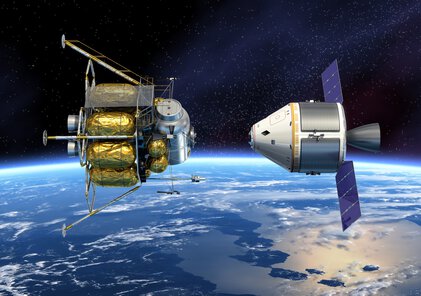Temperature Control Technology for Aerospace
The universe is infinite - and merciless. The satellites orbiting the earth are already witnessing this. In particular, the extreme temperature differences between the side of the earth facing the sun and away from the sun pose a real challenge on the orbit of the satellites. Since maintenance or repair is impossible, all materials and components, as well as the satellite itself, must undergo intensive testing for which temperature and vacuum resistance are critical.
Satellites and the Conditions Under Which They Must Work
Communication and the Internet, weather forecasts, TV programs - the modern human being is no longer able to live without satellite-communicated services. They provide the basis of global networking. More than 2,000 functioning satellites and the international space station ISS circle the globe.
Vacuum and temperature extremes place enormous demands on material and technology. For example, temperatures of up to +120 °C prevail on the moon during the long solar phase, while it becomes cold down to -130 °C in the shadow phase . The internally generated temperature, e.g., of the control electronics, must also be considered for technical devices in space. The challenge in the development of satellites is, therefore, to protect sensitive technology both from overheating and from a cold-related failure.
The vacuum does not make this easier: While heat conduction by convection can take place on earth for temperature compensation, this is not possible in a vacuum. Temperatures above -270 °C are generated in space primarily by the direct radiation of the sun. Their formation, therefore, also depends on how strongly the irradiated material absorbs the radiation. In addition, the vacuum influences the state of aggregation of liquid media: Lubricants, for example, evaporate due to the lack of air pressure.
Temperature Management in Space
To prevent the temperature from becoming too high due to the sun, outer materials are used, which reflect a large part of the radiant energy. Some satellites also rotate around their axis to evenly distribute direct sunlight. To ensure the operating temperature inside the satellite, booster heaters are partly installed, which allow a defined temperature control in contrast to direct sunlight. In addition, components can be wrapped with insulating material.
In the development process of a satellite, thermal models are used first to calculate the temperature developments in the satellite. These models are then tested on the test bench under conditions that are as realistic as possible, which include, in particular, low pressure, temperature extremes, and rapid temperature changes.
In most industries, products are extensively tested only during the development phase. After that, regular random checks are sufficient for quality assurance. Very different in aerospace: Every single satellite undergoes a full series of tests, which can take several weeks. This is due not only to the enormous effort and expense of any launch into space but also to the fact that maintenance or repair in space is impossible. In addition, it must be ensured that a satellite does not endanger the launcher during launch.
The Thermal Vacuum Chamber in Use
All operational and stress tests of satellites and individual components in them take place in so-called thermal vacuum chambers, in which both pressure and temperature can be precisely adjusted. Depending on the size of the test specimen, the thermal vacuum chamber must have considerable dimensions. However, the majority of today’s satellites is very compact: The small satellites known as cube satellites are only about the size of a shoebox. The small size not only makes transport to the orbit less expensive but also reduces the likelihood of damage from space debris and meteoroids. Another advantage is that they can be tested in significantly smaller thermal vacuum chambers, which are also less expensive to buy and operate.
High-performance temperature control systems provide the temperatures inside the chambers. In the tempering wall called the shroud, which surrounds the test specimen in a cylindrical shape, the temperature control medium is circulated in a closed circuit. A temperature interval of -80 °C to +180 °C can, e.g., be generated via a thermo-conducting oil as a medium. This thermo-conducting oil is cooled or electrically heated using a refrigerant as required. Lower temperatures can, e.g., be achieved using nitrogen in the shroud. In addition to this temperature ensured by the radiation of the shroud, a thermal plate can also be installed in the test area, on which the test specimen is positioned. This way, conducted heat transfers can also be simulated.
Test Procedure
In addition to the sensors of the satellite, numerous more are placed that, among others, closely monitor the temperature development. In addition to the delivery of all measured data, they also ensure the necessary safety of the test specimen. If damage could occur to components caused by overheating, the temperature inside the chamber is immediately lowered.
In the thermal balance test, in particular, the temperature distribution inside the satellite is determined and compared to the calculations of the thermal model. In the case of deviating results, reflective elements on the surface of the satellite can be removed, additional heating elements be installed, or the isolation of individual components be optimized, for example. The thermal cycling test checks the functionality of the test specimen after a defined number of cycles with changing temperature levels. Load and stress tests also provide information about the effects of extreme conditions on the test specimen.
Conclusion
Satellites are indispensable for a globally networked world. To be profitable, they must work reliably and maintenance-free under extreme conditions for several years. High-performance temperature control systems, such as the JULABO PRESTO series, provide the enormous temperatures in thermal vacuum chambers that reliably and reproducibly test satellites and all systems and components intended for space. The PRESTO devices are easy to use and, thanks to a sophisticated, modular range of accessories, extremely flexible and can be adapted to specific requirements. Our aerospace experts are always available to answer your questions.


